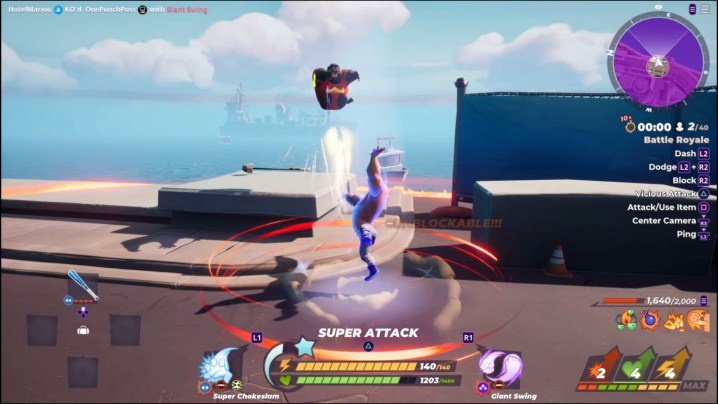
“Rumbleverse's unique fusion of battle royale structure and fighting game depth is a great, though sometimes imperfect, match.”
- Low entry barrier
- Frantic yet fun gameplay
- Excellent co-op multiplayer
- Maps rarely feel stale
- Lag can be a buzzkill
- Some overtuned mechanics
- Camera issues
Being a massive fan of Fortnite, I’ve grown to love the battle royale genre after being years late to the party. But before that, my competitive gaming was relegated solely to the fighting genre. When I heard that developer Iron Galaxy, the team behind the Killer Instinct reboot and various Capcom fighter re-releases, was creating a fighting game battle royale, it seemed like my two multiplayer passions could finally come together.
Melee-focused games of this genre aren’t new, but one by an esteemed fighting game developer had nothing but promise from an outside perspective. A battle royale with the game plans, frame data, and all-around quirks of something like Street Fighter? Could it really be done well? Rumbleverse showed me that it can, albeit with a few growing pains of one genre trying to fit into another.
A build and beat-em-up battle royale
Rumbleverse mixes the gameplay philosophies of fighting games and battle royales. During matches, 20 players are thrown into a circle that changes closes in on the game’s map, Grapple City. As soon as they touch down, players are tasked with building their character and fighting it out melee style using rolls, shields, various items, and the environment around them.

Unlike its shooter-focused siblings in the genre, players don’t just equip themselves with loot; they’re making a character instead. After deciding where to drop, players search for protein-filled pots that raise various stats. These pots include red ones that boost damage output, green pots that increase overall health, and yellow stamina pots which allow players to dodge and sprint more. The effective twist is that players only have 10 stat boxes (eight in duos), so they’ll have to be thoughtful about what they pick up to create a specialized build.
In addition to that character building, there are special moves that can be learned by picking up and reading books. The specials are split into two types: strike and vicious. Strikes are physical attacks that can be blocked like sumo slaps and strong punches. Meanwhile, vicious specials are unblockable command grabs that must be jumped, rolled, or struck out of. Like Fortnite, each of these specials is split into different rarities, green being the standard, blue being rare, and purple being epic. The secret to success is trying to plan for where the final phase of battle might take place and picking attacks that’ll be most effective in that setting. For instance, if I know the final stage of battle will land near water, I might want to equip a swinging attack that lets me toss my foes out to sea.
Rumbleverse has a low entry barrier for new players, but a surprisingly deep battle system.
On top of all that, players will need to learn the game’s attack priority list, which determines what kinds of moves counter one another. However, the game isn’t terribly clear about it; I found this all out on my own through wikis and streamers. While the game has its own tutorial hidden inside the Playground mode, Rumbleverse lacks a much-needed upfront tutorial that isn’t just delivered as a wall of text with no context.
A battle royale with a lot of depth
Rumbleverse has a low entry barrier for new players, but a surprisingly deep battle system too. Not only will players have to master all of it to defeat foes, but they must battle against the random factors that come with a battle royale too.
Like the Super Smash Bros. series, the game is easy and simple but hard to master.
During fights, I have to watch for my life bar, super bar, stamina bar, remember what’s in my inventory, watch my surroundings for third-party fighters, recognize my combo opportunities, react to rolls and attacks to punish and dodge, and more. It turns the experience into one of the most frantic in both genres it’s pulled from — and that complexity goes up tenfold when playing duos.
I found myself using actual fighting game tactics when in 1v1 situations, adding my Fortnite fundamentals in when exploring to make sure no one got the drop on me. It’s an unexpected match made in heaven. And thanks to some ever-changing locales, matches rarely get stale as players are forced to recognize their surroundings and use them to their advantage.
For example, at the end of one duos match, a friend and I had to fight against one player. This battle took place atop a building next to an open ocean, which spells death for any player that lands in it. I recognized this and knocked my opponent into a wall. As they were momentarily splatted there, I added on extra stun with a weapon. Thanks to my ally holding on to an enormous range throw ability, Giant Swing, we were able to quickly win the match with one well-timed combo that ended in a ring-out.

Moments like that turn the experience into such a special one. Even just playing casually, players may naturally find that their fundamentals and fight sense are getting better with every match.
Wrestling with mechanics
While the basic idea is excellent, my issues lie in how the game sometimes can break its own rules. Everything needs to be on point in a game that is simple but expects so much out of the players. That isn’t always the case here.
To start, the tracking is very inconsistent. A core part of the game is recognizing even the most minor misstep in your opponent’s play, allowing you to turn the tides of battle in your favor. To help with this, many moves have a vacuum effect that pulls your enemy slightly toward you, allowing fighting game-like punishes in a battle royale environment. During my time playing and watching, this wasn’t always the case. Attacks sometimes lock onto entirely different targets and even sometimes empty air. If I could count the times I blew an advantageous moment because I punched a trash can or air vent instead, I’d run out of fingers.

These inconsistencies carry over into other attack types as well. Moves like the Spear command seem to have the most inconsistent tracking, sometimes zigzagging to hit players even after they’ve correctly dodged them. Other times it goes two inches in front of the player, whiffing and setting up for significant punishment despite it being the right decision. This also happens with super abilities, with moves ofter either completely missing or tracking foes from miles away.
Button priority is an issue too. When you activate super mode, you can blast enemies away with an explosion or activate instant invincibility and go right into your super. Both of these effects are great for different situations in the game. However, if you happen to be standing near an item, your character will pick that up instead of doing either. This error spells instant death for anyone looking to use their escape card and results in a frustrating finish.
There are a few fixes that the game needs to be given before it grabs that world championship belt.
Attack priority creates some headaches too, especially when it comes from weapons that players can pick up off the streets and use to attack. Weapons are high-priority tools that also come with vicious attacks which can’t be blocked and have very fast recovery speeds. When players encounter an armed player, at times, the best thing they can do is run away. At other times, I can’t even tell where these attacks are coming from due to how rough the camera can be. In areas like tunnels and halls, I’m lucky to even be able to see who’s coming after me.
Rumbleverse asks a lot from players when it comes to their reaction time, but it has a tendency to lag often. Like any fighting game, you will not have a good time if you can’t react quickly or your opponent simply has a bad connection that makes them difficult to hit. Thankfully, developer Iron Galaxy has already been working quickly to fix those issues, putting the game on a healthy path to success.

Rumbleverse weds two previously unrelated genres and creates something unique, fun, and promising from a competitive perspective. Like Fortnite and fighting games, it carefully balances casual play with complex depth. If it’s your cup of tea, you’ll eventually find yourself getting better without even going into the game’s Playground training mode. However, there are a few fixes that the game needs to be given before it grabs that world championship belt. Iron Galaxy has been tending to the game bit by bit, and it’ll most likely address more issues in the future. I believe the game is in good hands, and hopefully, by the time you read this review, some of these problems will fixed already. The good news though? It’s free-to-play, so at least you aren’t paying money for those issues.
Rumbleverse was tested on Xbox Series X and PlayStation 5.
Editors' Recommendations
- The best free PS5 games
- Epic Games’ new battle royale Rumbleverse launches August 11
- Fortnite adds mechs to Battle Royale, and competitive players are not happy
- Stranger Things is turning the Fortnite: Battle Royale map upside down




